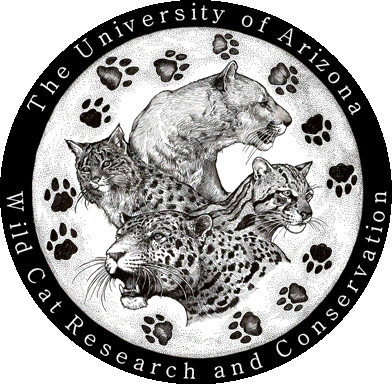Genetics
The UA Wild Cat Research and Conservation Center has been monitoring wildlife across Southern AZ/New Mexico for a variety of projects since 2009. We have undertaken a focused jaguar and ocelot detection effort, including the analyses of scat in the Culver Conservation Genetics Lab.
Collaboration & Mentorship
The Culver Conservation Genetics Lab and the Wild Cat Center welcomes and encourages mentorship. We support students, interns, and fellow researchers. The lab has collaborated with Cochise College in Sierra Vista, Arizona to train students involved in the Jaguar & Ocelot Monitoring Project. Culver lab members trained students on fecal DNA extraction protocols and sample preparation for genetic sequencing for species identification.
Culver Genetics Lab
The Culver Conservation Genetics Lab pursues genetic and genomic research along with camera trap monitoring. The lab integrates systematics, population biology, evolution, and disease related knowledge and modeling in order to gain a more robust understanding of ecological systems and biodiversity. The genetic analyses performed on over 30 different species has assisted management decision-making for these species.(Culver Conservation Genetics Lab – University of Arizona)
eDNA
eDNA is another tool researchers from the UA WCC are utilizing. The sampling is conducted, from collecting and filtering water, sediment, and soil samples for genetic analyses, to detect the biodiversity of mammals/herps/birds, from ephemeral ponds/pools or creeks. This process provides information about status of biodiversity, community composition, and rare species. Results also help inform which water sources are being used most often which is important for conservation.
See our genetics projects below…
Jaguar and Ocelot Survey and Monitoring Project in the US
-
-
-
The University of Arizona (UA) established and implemented a non-invasive system for detecting and monitoring jaguars (Panthera onca) in southeastern Arizona and southwestern New Mexico for U.S. Fish and Wildlife Service in 2011. The PI of this study has expertise conservation genetics so the contract included a genetic component. The genetic analyses involved scat collected with the help of a scent detection dog and collected opportunistically from citizen scientists. During the project, 51 jaguar scats were genetically analyzed for species ID and 17 of those were verified as jaguar in the Culver Conservation Genetics Lab. These scats now provide the opportunity for ongoing diet analyses of the jaguar.





